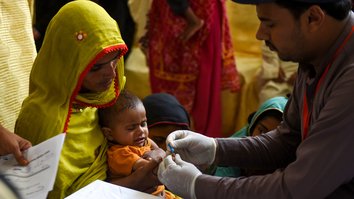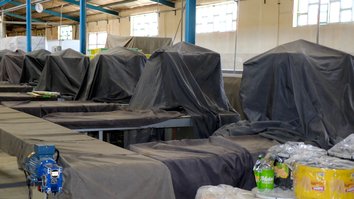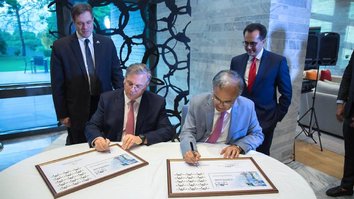PESHAWAR -- The Khyber Pakhtunkhwa (KP) government, in collaboration with the World Health Organisation (WHO) and Médecins Sans Frontières (MSF), has treated more than 20,000 patients infected with cutaneous leishmaniasis over the past year.
Cutaneous leishmaniasis is caused by parasites spread by certain types of sandfly and can result in disfiguring sores.
The disease has affected more than 25,000 patients over the past year and a half, mostly in the merged tribal districts.
MSF, which runs the only centre in Peshawar treating the disease, received 2,329 critical-condition patients last year. A new centre in Bannu will become operational in September, said MSF country representative Thomas Balivet.
![An Afghan woman with leishmaniasis awaits treatment at Naseerullah Khan Babar Memorial Hospital in Peshawar January 13. [KP Health Department]](/cnmi_pf/images/2019/07/09/18849-cl2-585_329.jpg)
An Afghan woman with leishmaniasis awaits treatment at Naseerullah Khan Babar Memorial Hospital in Peshawar January 13. [KP Health Department]
"The disease leaves scars on the body, and we are closely working with the government to end the disease," he said, adding that the transmission of the virus is preventable by sleeping under nets and wearing long sleeved shirts in high-risk areas.
The number of infected patients is growing, Balivet said. Patients from 23 districts have received treatment at the Peshawar facility since its establishment at the Naseerullah Khan Babar Memorial Hospital Peshawar (NKBMH) in May 2018.
Deep concern about the outbreak exists, and MSF wants the government to make the treatment for the disease available, affordable and adapted to the needs of the patients, according to Balivet.
MSF also has two centres "in the Quetta and Kuchlak areas of Balochistan", he said. Such facilities are the only ones that provide comprehensive diagnoses, treatment and counselling to patients.
"As the first priority, we want to provide treatment to leishmaniasis patients and then take measure to prevent the sickness, which is not fatal but causes lifelong scarring."
The lifelong scarring caused by the disease leads "to the disfigurement of faces and limbs, and therefore those infected -- especially women -- face social rejection", Balivet said.
Challenges to public health efforts in Pakistan include efforts by the Tehreek-e-Taliban Pakistan (TTP) to spread ignorance and misinformation about the causes of polio. The TTP has resorted to assassinating polio vaccinators.
Building capacity
"The majority of the victims are female and children. We have imported 70,000 injections for the patients," said Dr. Qutbuddin Kakar, WHO national professional officer.
The WHO has organised a five-day training course for dermatologists on how to manage patients effectively, he said.
"Alongside treatment, we are also taking measures for vector control to eliminate the sandfly types that transmit the infection," Kakar said. The disease is preventable, but an acute outbreak occurred because glucantime injections, the main treatment, were not available in Pakistan, he added.
Medics have launched a prevention programme to scale up public awareness on staying safe from sandfly bites and on avoiding the disease, he said.
The WHO has issued guidelines regarding the administration of injections to achieve the most effective results, according to KP Secretary for Health Syed Farooq Jamil.
The KP government, alongside the army and international organisations, has launched measures to control cutaneous leishmaniasis by asking Pakistanis to avoid bites and to undergo treatment at the nearest hospital.
"Following the outbreak, we have set up centres in each of the endemic districts to stop the spread of the disease. We are hiring 50 entomologists to cope with the sandflies in the province," Jamil said.
The NKBMH has also been receiving patients from Afghanistan and from Punjab Province, including Islamabad, said Dr. Siraj Muhammad, medical superintendent of the NKBMH.
Because of the patient load, the NKBMH is setting up regional centres in the province to treat residents in their native districts, he said.
Healing
Ghaffar Ali, 14, a resident of Matani village near Peshawar, said he used to cover his face because others who saw his leishmaniasis scars looked down on him.
"Now, my wound has completely healed through treatment," he said.
Shamala Bibi, a 23-year-old from South Waziristan, said she is living with relatives in Peshawar to receive treatment at the centre.
"Initially, I faced many problems from residents of our village because they don't want to look at me, but now my wound has improved greatly. Even the scars are disappearing," she said.
"Even my close relatives were unwilling to share a meal with me," she said. "They gave me separate crockery and towels, etc., because of fear of contracting the sickness."
Hundreds of patients in her village have problems because the other residents do not want to see them, she said.
Syed Jamal, a schoolteacher who took his sons to the centre for the treatment, said the disease was widespread in his neighbourhood in Miranshah Tehsil, North Waziristan.
The government and army centres provide free treatment to the patients, he said, adding that most patients do not know about the disease and mistake symptoms for mosquito bites, later spreading the infection to close family members.
Both of Jamal's sons, age 10 and 13, have improved considerably, he said.
"We have come here four times, but the wounds have now been healed, and doctors say the thin scars on their face will disappear soon," he said.

![A man with sores caused by leishmaniasis can be seen in this photo taken in April in Peshawar. [Médecins Sans Frontières]](/cnmi_pf/images/2019/07/09/18848-cl-585_329.jpg)






